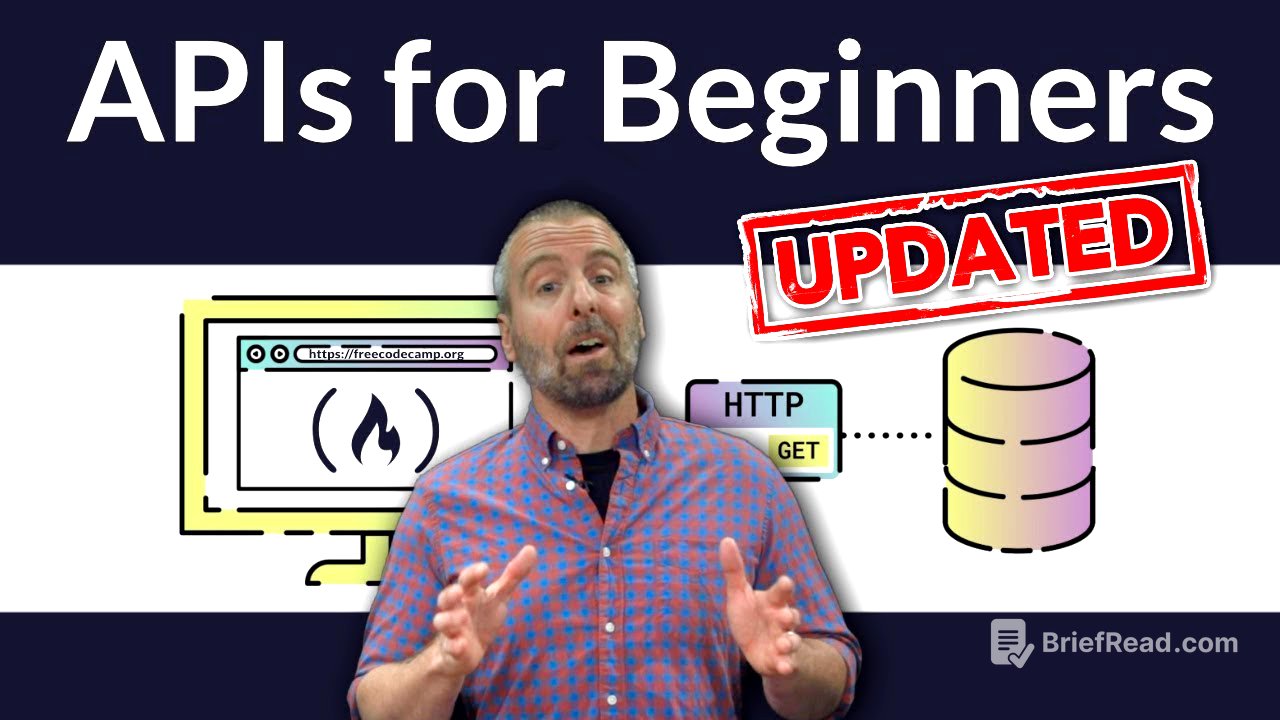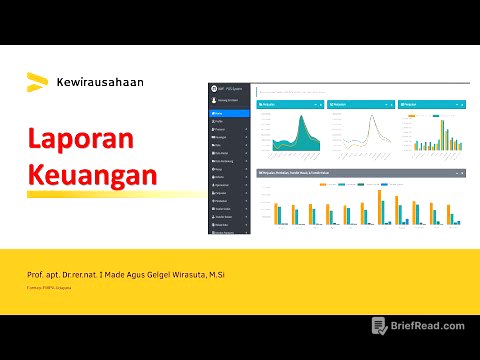TLDR;
This course provides a comprehensive introduction to APIs (Application Programming Interfaces), explaining their purpose, benefits, and practical usage. It covers various types of APIs, including web-based, language-specific, and remote APIs, with a focus on RESTful APIs. The course also teaches how to explore and interact with APIs using tools like Curl, Postman, and helper libraries, and culminates in building a web application that utilizes the Twilio API for user-submitted photos via text messages.
- APIs are contracts that define how software components should interact, abstracting away implementation details.
- REST (Representational State Transfer) is a popular architectural style for web-based APIs, emphasizing stateless communication and resource-based interactions.
- Tools like Curl, Postman, and helper libraries simplify API exploration and integration into applications.
Introduction to APIs [0:00]
The course will explore APIs, explaining what they do, why they exist, and their benefits. Participants will gain hands-on experience with web APIs. Basic coding experience and web knowledge are recommended but not required, with resources provided for beginners. The course is an updated version of a previous offering, incorporating learner feedback. The instructor encourages active participation, including using captions, adjusting playback speed, and taking breaks to absorb the material.
What is an API? [3:13]
The term API, or Application Programming Interface, is broken down by first focusing on the "I" for interface. Interfaces, whether physical or software-based, allow users to control functionality without understanding the underlying implementation. Examples include radio controls, alarm clocks, and graphical user interfaces (GUIs) like play buttons in streaming apps. Developers also use interfaces, such as buttons provided by application frameworks, which abstract away the complexities of button interaction. APIs define how to interact with objects, abstracting implementation details and enabling control over features.
Why APIs? [8:45]
An API is a contract that defines how it is expected to be used and what you can expect to receive by using it. APIs are tools for software developers, providing access to data and abstracting implementation details, saving developers from creating everything themselves. The term API often refers to web-based APIs, but APIs are prevalent in programming languages, web browsers, libraries, and frameworks. Programming languages provide APIs for common tasks like string manipulation and file system operations, while web browsers implement web APIs to ensure code compatibility across different browsers. Libraries and frameworks also offer APIs to solve common problems and extend functionality.
Remote APIs [13:44]
Remote APIs enable control of objects and access to data and computational power remotely. Examples include TV remotes, robots, traffic signs, drones, and apps that identify songs or translate languages in real-time. REST (Representational State Transfer) emerged as a popular architectural style for remote APIs, allowing developers to interact with specific resources over the web. REST's popularity has led to the term API often being used synonymously with RESTful APIs, although other approaches like GraphQL exist. The course will focus on RESTful APIs.
How the Web Works [17:55]
A review of how the web works is presented, covering terms like web clients, servers, URLs (Universal Resource Locators), and HTTP (Hypertext Transfer Protocol). HTTP is a protocol that defines the expectations of how to communicate between a client and a server. The client sends an HTTP request to the server, specifying a URL and an HTTP verb (e.g., GET to receive data, POST to submit data). The server processes the request and sends back a response, including a body (e.g., HTML for a webpage) and headers (e.g., status code). HTTP is a stateless protocol, and additional information is passed through query string parameters and headers.
RESTful APIs [23:17]
REST, or Representational State Transfer, is an architectural style for APIs that leverages web technologies. RESTful APIs involve a client making a stateless HTTP request to a server, requesting information about a resource. A resource is an abstract object that can represent anything in an application, such as books, authors, photos, or users. Common operations on resources are expressed through CRUD (Create, Read, Update, Delete), which map to HTTP methods like POST, GET, PATCH and DELETE. Data is typically represented in JSON (JavaScript Object Notation). By using HTTP methods, any application can interact with a REST API.
Exploring a RESTful API: Spotify [28:51]
The Spotify API is explored as an example of a RESTful API. The Spotify Developer site provides documentation, APIs, and SDKs for various platforms. The Spotify Web API returns JSON data about music, artists, albums, and tracks, using REST principles. It uses URIs to get specific data, with authorization required for certain actions. The API supports GET requests to retrieve resources and POST requests to create resources. The Spotify API console allows users to test API calls directly from the browser, constructing queries and viewing responses in JSON format.
Using Curl [44:55]
Curl, a command-line tool for sending data, is introduced as a way to interact with APIs from a computer. Instructions are provided for installing Curl on different operating systems. Curl commands can be used to make HTTP requests to APIs, specifying parameters and headers. The Spotify API is used as an example, with Curl commands to search for artists and retrieve album information. The JQ tool is introduced as an optional way to format JSON output in the terminal.
Using the Twilio API [56:04]
Twilio, a company that provides communication APIs, is introduced. Instructions are provided for signing up for a free Twilio trial account. The Twilio API allows developers to send text messages (SMS) and make phone calls with a single command. The process of obtaining a Twilio phone number and sending a text message using Curl is demonstrated. The Twilio documentation is highlighted as a valuable resource.
REST API Clients [1:14:15]
REST API clients, such as Postman and REST Fox, are introduced as visual tools for exploring APIs. REST Fox is used to explore the Govee API for controlling a smart lamp. The process of creating a new folder and request in REST Fox is demonstrated, along with how to specify the request URL, parameters, and authentication. The Twilio API is used as an example, with REST Fox used to retrieve incoming messages and send a text message with a picture. The concept of environments is introduced as a way to store and reuse common values, such as API keys and authentication tokens.
Exploring APIs with Postman [1:36:11]
Postman is introduced as a powerful tool for exploring APIs. The Postman API Network is highlighted as a resource for finding pre-built collections for popular APIs, including Twilio. Postman allows users to generate code snippets in various programming languages for making API calls. The Twilio Postman collection is explored, demonstrating how to send an SMS message using the Postman interface.
Helper Libraries [1:49:27]
Helper libraries or SDKs (Software Development Kits) are introduced as a way to simplify API interactions in code. Helper libraries abstract away the complexities of making HTTP requests and provide a more concise and legible code. The Twilio helper library for Node.js is used as an example, demonstrating how to list messages and send a text message. The concepts of asynchronous programming and promises in JavaScript are explained.
Building a Web Application [2:15:21]
The course culminates in building a web application that displays user-submitted photos via text messages. The application uses HTML, CSS, and JavaScript, with the View framework for the front end. The process of deploying the application to Twilio's serverless environment is demonstrated. The application uses a Twilio function to handle incoming messages and store the submitted photos.
Coding the API [2:37:41]
The process of creating a web-based API to return the submitted photos in JSON format is demonstrated. A Twilio function is used to retrieve the messages from the Twilio API and format them into the expected JSON structure. The API is designed to be publicly accessible, allowing the client-side application to retrieve the data. The importance of shaping the data to match the expected format is emphasized.
Consuming the API [2:57:13]
The final step involves consuming the API in the client-side application. The Fetch API is used to retrieve the JSON data from the API and display the photos in the gallery. The completed application allows users to submit photos via text message and view them on a webpage. The course concludes with a review of the RESTful API constraints and a call to action for learners to continue exploring and building with APIs.








![Learn Python - Full Fundamental Course for Beginners | Python Tutorial for Beginners [2019]](https://wm-img.halpindev.com/p-briefread_c-10_b-10/urlb/aHR0cDovL2ltZy55b3V0dWJlLmNvbS92aS92X1M2NGtsZHJ5Yy9ocWRlZmF1bHQuanBn.jpg)
